How Warehouse Automation Technologies Enhance Efficiency

Warehouse automation transforms logistics by streamlining operations and reducing human error. The rapid growth of e-commerce has increased demand for faster order processing and delivery. Companies now rely on automation in warehouse operations to meet these expectations. Mobile robots, which accounted for 53% of warehouse robotics demand in 2022, highlight this trend. Additionally, 85% of businesses plan to adopt automation within the next year. Automated systems, such as sorting equipment and conveyor belts, enable warehouses to process orders more efficiently, ensuring accuracy and speed. These advancements are essential for modern supply chains.
Types of Warehouse Automation Technologies

Automated Storage and Retrieval Systems (AS/RS)
How AS/RS Enhances Efficiency
Automated storage and retrieval systems streamline warehouse operations by automating the movement and storage of goods. These systems use advanced robotics to handle repetitive tasks, reducing human error and increasing warehouse efficiency. Robotic shuttle systems, for example, operate on narrow rails and achieve throughput rates of 200 to 700 lines per hour. They can handle weights ranging from 35 to 110 pounds. Robotic cube storage systems stack inventory in bins within a cube, allowing smart robots to retrieve and sort items efficiently. These systems offer modular expansion, making them adaptable to changing warehouse needs. Floor robots, such as AGVs and AMRs, transport portable shelving to operators, making them ideal for slow to medium velocity inventory.
Benefits of AS/RS in Warehouse Operations
AS/RS improves workflows by optimizing storage and retrieval technology. It reduces the need for manual labor, leading to significant cost savings. These systems also enhance warehouse safety by minimizing human interaction with heavy equipment. By integrating with warehouse management systems, AS/RS provides real-time inventory tracking, ensuring accurate stock levels. The modular design of these systems allows warehouses to scale operations as needed, making them a versatile solution for modern logistics.
Goods-to-Person (GTP) Systems
How GTP Systems Work
Goods-to-person systems revolutionize warehouse automation by bringing items directly to workers. Unlike traditional methods that require workers to navigate aisles, GTP systems use robotics to transport goods to designated stations. AutoStore, a popular GTP system, eliminates the need for extensive conveyor infrastructure. This setup enhances space efficiency and reduces the risk of operational halts caused by equipment failure. Built-in redundancy ensures that robots operate independently, maintaining reliability even during maintenance.
Advantages of GTP Systems for Order Fulfillment
GTP systems improve warehouse efficiency by reducing the time workers spend searching for items. They enhance accuracy in order fulfillment, minimizing errors. These systems also optimize space utilization, as they do not require dedicated aisles for shuttles. By integrating with inventory management software, GTP systems provide real-time data, enabling better decision-making. Their flexibility and reliability make them an essential component of advanced automation in warehouses.
Automated Guided Vehicles (AGVs) and Autonomous Mobile Robots (AMRs)
Differences Between AGVs and AMRs
AGVs and AMRs play distinct roles in warehouse automation. AGVs follow fixed routes, making them suitable for repetitive tasks. In contrast, AMRs use intelligent navigation to adapt to dynamic environments. This flexibility allows AMRs to perform a variety of tasks without requiring predefined paths. Modern warehouses benefit from AMRs' ability to handle complex workflows efficiently.
Use Cases for AGVs and AMRs in Warehouse Automation
AGVs and AMRs enhance warehouse technology by automating material transport and inventory management. Their advanced safety systems, including emergency stop buttons and laser scanners, ensure safe operation around personnel. These robots optimize space utilization and reduce labor costs by automating repetitive tasks. The AMR market is projected to grow significantly, reaching $23.69 billion by 2028. This growth highlights their importance in improving operational transparency and efficiency in warehouses.
Drones and Smart Warehousing Solutions
Applications of Drones in Inventory Management
Drones are revolutionizing warehouse automation by streamlining inventory management processes. These advanced devices navigate warehouse aisles, capturing real-time data on stock levels and product placements. Companies like IKEA have adopted AI-powered drones that use intelligent algorithms to identify and photograph storage locations. This innovation ensures inventory accuracy and allows 24/7 operations, reducing the physical strain on employees. Penske Logistics has also piloted drones to verify product placements and provide real-time inventory updates. These applications minimize human error and accelerate inventory counts, showcasing the potential of drones in enhancing warehouse technology.
Benefits of Drones in Warehouse Technology
Drones offer several advantages that improve warehouse efficiency. They reduce the time required for inventory checks by automating the process. Their ability to operate continuously ensures that warehouses can maintain accurate stock levels without interruptions. By minimizing manual labor, drones lower operational costs and enhance employee satisfaction. Additionally, their integration with warehouse management systems provides real-time data, enabling better decision-making. These benefits make drones a vital component of modern warehouse automation.
Implementation Strategies for Warehouse Automation
Assessing Your Warehouse Needs
Assessing warehouse needs is the first step toward implementing automation. Businesses must evaluate several factors to determine the right approach.
Major drivers like labor availability, costs, and turnover rates should be analyzed.
Problematic functions requiring improvement must be identified. For example, inefficient workflows or manual inventory tracking may benefit from automated processes.
Critical data analysis is essential. Real-time data and predictive analytics help evaluate current operations and identify areas for automation.
Additional considerations include cost-benefit analysis, workforce impact, and vendor selection. Companies should assess the initial investment, operational costs, and potential return on investment. Training programs and job redesigns prepare employees for the transition. Selecting experienced vendors ensures reliable support and customization options. Future-proofing strategies, such as staying updated on warehouse technology trends, guarantee long-term success.
Choosing the Right Types of Warehouse Automation Technologies
Selecting suitable warehouse automation technologies requires aligning them with business goals. Companies should prioritize scalable solutions that grow with their operations. Integration capabilities with existing systems, such as warehouse control systems, are crucial for seamless implementation.
Thorough market research and consultations with industry experts provide valuable insights. Businesses can analyze competitor technologies and learn from their experiences. Feedback from other users offers practical perspectives on the effectiveness of specific solutions. Trial tests allow companies to evaluate shortlisted technologies, ensuring they meet operational requirements. For example, robotic arms and voice picking systems can enhance workflows and improve warehouse efficiency.
Planning and Budgeting for Automation in Warehouse Operations
Planning and budgeting are critical for successful automation implementation. Costs vary based on the level of automation, warehouse size, and complexity. Basic systems may cost between $10,000 and $50,000, while advanced automation solutions can range from $500,000 to several million dollars. Fully automated dark warehouses may require investments of up to $25 million.
Factors influencing costs include customization needs, supplier choice, and scalability. Maintenance, training, and regulatory compliance also contribute to expenses. Establishing a clear implementation timeline with defined phases and milestones ensures smooth execution. Contingency plans address potential challenges, minimizing disruptions. By carefully planning and budgeting, businesses can achieve end-to-end automation and maximize their return on investment.
Training and Upskilling the Workforce
Training employees to adapt to warehouse automation ensures a smooth transition and maximizes efficiency. Tailored training programs help staff understand new technologies like AMRs, voice picking systems, and collaborative robots. These programs focus on the specific needs of the workforce, ensuring effective learning. Establishing a continuous learning culture encourages employees to stay updated on advancements in robotics and inventory management software. This approach fosters adaptability and long-term growth.
Engaging employees throughout the automation process builds enthusiasm and support. Managers should involve staff in discussions about workflows and listen to their feedback. This collaboration improves the implementation of automation strategies. Certification programs can motivate employees by rewarding their efforts in mastering advanced technologies. Periodic refresher courses keep the workforce informed about updates in RFID systems and other automation tools.
The table below outlines best practices for training warehouse staff:
Best Practice | Description |
|---|---|
Tailored Training Programs | Craft training programs specifically designed for the new automation systems. |
Continuous Learning Culture | Foster an environment that encourages ongoing education and adaptation. |
Feedback Loops | Establish mechanisms for staff to provide feedback on training effectiveness. |
Certification Programs | Introduce programs that reward employees for completing training. |
Refresher Courses | Offer periodic training updates to keep staff informed about new developments. |
By prioritizing these practices, businesses can ensure their workforce remains skilled and confident in using warehouse automation technologies.
Partnering with JUSDA for Advanced Warehouse Technology Solutions
JUSDA offers comprehensive solutions for businesses seeking to implement advanced warehouse automation. With over 15 years of experience, JUSDA provides tailored services that integrate cutting-edge robotics and inventory management software. Their global network of warehouses, spanning regions like China, Vietnam, and the United States, ensures seamless operations for diverse industries.
JUSDA’s JusLink platform enhances transparency and efficiency by leveraging IoT and cloud computing. This technology enables real-time tracking of workflows and inventory, reducing errors and improving decision-making. Businesses benefit from JUSDA’s expertise in deploying AMRs, RFID systems, and other automation tools. These solutions optimize space utilization and streamline operations, making them ideal for modern logistics.

JUSDA Solutions
To provide you with professional solutions and quotations.
Collaborating with JUSDA ensures access to advanced technologies and expert support. Their value-added services, such as picking, packing, and labeling, further enhance warehouse efficiency. By partnering with JUSDA, companies can achieve scalable and reliable automation, staying competitive in a rapidly evolving market.
Overcoming Challenges in Warehouse Automation

Managing High Initial Costs
Strategies for Cost-Effective Implementation
High initial costs often deter businesses from adopting warehouse automation. These expenses include purchasing and installing automated systems, ongoing maintenance, and integration with existing technologies. However, businesses can overcome these challenges by implementing cost-effective strategies:
Review current processes to identify inefficiencies and prioritize automation in those areas.
Set clear objectives to ensure automation aligns with business goals.
Select scalable technologies that grow with operational needs.
Use data-driven decision-making to optimize resource allocation.
Build strong vendor relationships for reliable support and cost-effective solutions.
Perform regular maintenance to extend the lifespan of automated systems.
Viewing automation as a long-term investment helps businesses focus on its future benefits, such as reduced labor costs and improved efficiency.
Workforce Adaptation to Automation
Training Programs for Seamless Transition
Employees often resist automation due to fears of job loss and the need for new skills. Effective training programs can address these concerns and ensure a smooth transition. Companies should develop detailed training modules tailored to the new systems. Workshops with experts provide hands-on learning opportunities, while certification programs incentivize skill development.
Virtual reality (VR) training offers an innovative approach. For example, FedEx uses VR to train staff in operating and repairing robots. This method reduces turnover, lowers costs, and boosts employee confidence. Establishing feedback loops ensures continuous improvement in training processes. Periodic refresher courses keep employees updated on advancements like voice picking systems.
Promoting a culture of collaboration between humans and machines fosters acceptance. Leaders should emphasize that automation enhances roles by reducing repetitive tasks, allowing employees to focus on complex responsibilities.
Maintenance and Downtime
Ensuring Reliable Operations with JUSDA Support
Maintaining automated systems is essential for minimizing downtime and ensuring smooth warehouse operations. Regular audits of automated systems help identify minor issues before they escalate. Conducting these audits at least once a year ensures that systems remain efficient and reliable. Performing routine maintenance and upgrades further enhances the longevity of warehouse automation technologies. These practices prevent unexpected breakdowns and optimize system performance.
Effective communication between the warehouse management system (WMS) and automation systems plays a critical role in preventing operational disruptions. Seamless integration ensures that all components work harmoniously, reducing the risk of errors. For example, technologies like voice picking systems rely on accurate data flow to function effectively. Any miscommunication between systems can lead to delays or inaccuracies in order fulfillment.
JUSDA provides robust support to ensure reliable operations in automated warehouses. Their JusLink platform integrates IoT and cloud computing to offer real-time monitoring and predictive maintenance. This technology identifies potential issues early, allowing businesses to address them proactively. JUSDA's global network of warehouses, equipped with advanced automation tools, ensures uninterrupted operations across diverse industries.
JUSDA also offers tailored maintenance plans to meet the unique needs of each client. These plans include regular system checks, software updates, and hardware inspections. Their expert teams provide 24/7 support, ensuring quick resolution of any technical issues. By partnering with JUSDA, businesses can maintain high operational efficiency and minimize downtime.
Reliable maintenance practices and expert support from JUSDA enable companies to maximize the benefits of warehouse automation. These strategies ensure that automated systems operate at peak performance, supporting the fast-paced demands of modern logistics.
Warehouse automation technologies are revolutionizing logistics by enhancing efficiency, accuracy, and scalability. These advancements streamline operations, reduce errors, and improve productivity. For example, automation minimizes decision-making for employees, leading to fewer picking errors and faster processing times. Businesses adopting these technologies gain a competitive edge through cost savings, optimized space utilization, and improved customer service.
Strategic planning ensures successful implementation, addressing factors like scalability and IT infrastructure. Partnerships with experts like JUSDA further enhance outcomes. JUSDA’s solutions, such as JusLink, improve supply chain performance with smart forecasting and real-time tracking. Companies leveraging these innovations can achieve long-term benefits, including increased throughput and reduced operational costs.
"The scalability of an automation solution essentially breaks down into three areas: reliable, adaptable, and usable."
By embracing warehouse automation, businesses can meet modern logistics demands and secure sustainable growth.
See Also
Understanding Robotic Automation's Role In Warehouse Efficiency
The Importance Of Automating Your Warehouse Operations Today
Exploring The Advantages Of Automated Manufacturing Warehousing
Boosting Warehouse Productivity Through Advanced Logistics Robotics
